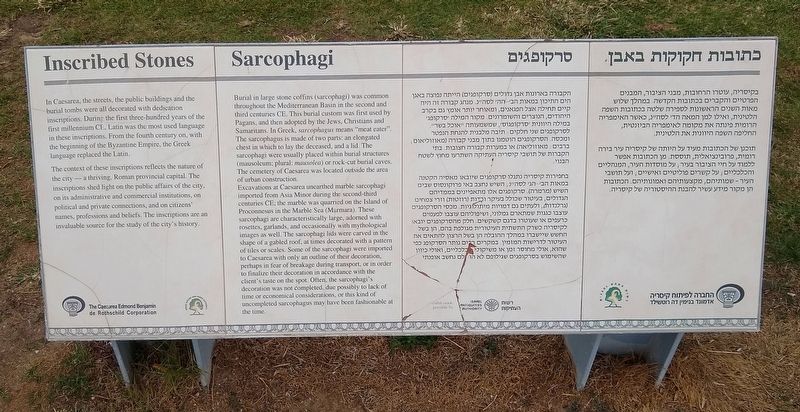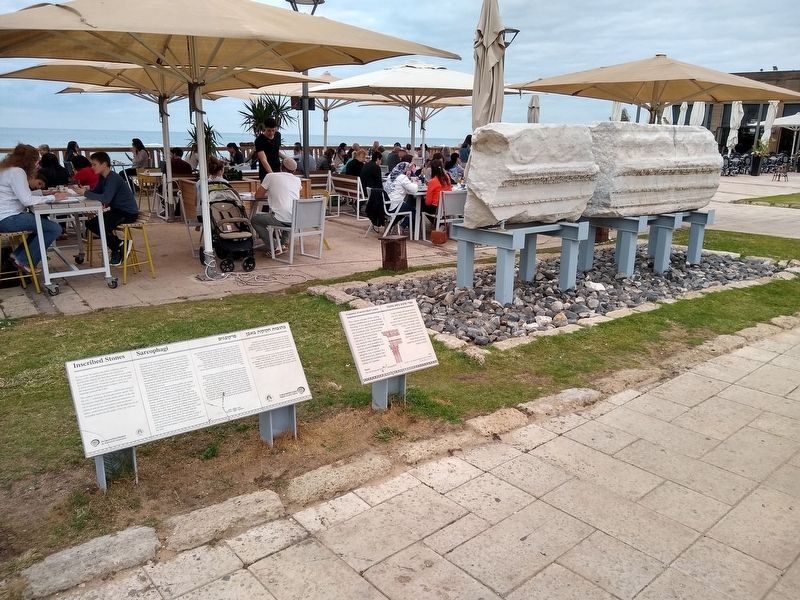Sdot Yam in Hadera, Haifa District, Israel — West Asia (the Levant in the Middle East)
Inscribed Stones / Sarcophagi
In Caesarea, the streets, the public buildings and the burial tombs were all decorated with dedication inscriptions. During the first three-hundred years of the first millennium CE, Latin was the most used language in these inscriptions. From the fourth century on, with the beginning of the Byzantine Empire, the Greek language replaced the Latin.
The context of these inscriptions reflects the nature of the city – a thriving, Roman provincial capital. The inscriptions shed light on the public affairs of the city, on its administrative and commercial institutions, on political and private connections, and on citizens’ names, professions and beliefs. The inscriptions are an invaluable source for the study of the city’s history.
Sarcophagi
Burial in large stone coffins (sarcophagi) was common throughout the Mediterranean Basin in the second and third centuries CE. This burial custom was first used by Pagans, and then adopted by the Jews, Christians and Samaritans. In Greek, sarcophagus means “meat eater”. The sarcophagus is made of two parts: an elongated chest in which to lay the deceased, and a lid. The sarcophagi were usually placed within burial structures (mausoleum; plural: mausolea) or rock-cut burial caves. The cemetery of Caesarea was located outside the area of urban construction.
Excavations at Caesarea unearthed marble sarcophagi imported from Asia Minor during the second-third centuries CE; the marble was quarried on the Island of Proconnesus in the Marble Sea (Marmara). These sarcophagi are characteristically large, adorned with rosettes, garlands, and occasionally with mythological images as well. The sarcophagi lids were carved in the shape of a gabled roof, at times decorated with a pattern of tiles or scales. Some of the sarcophagi were imported to Caesarea with only an outline of their decoration, perhaps in fear of breakage during transport, or in order to finalize their decoration in accordance with the client’s taste on the spot. Often, the sarcophagi’s decoration was not complicated, due possibly to lack of time or economical considerations, or this kind of uncompleted sarcophagus may have been fashionable at the time.
בקיסריה, עוטרו הרחובות, מבני הציבור, המבנים הפרטיים והקברים בכתובות הקדשה. במהלך שלוש מאות השנים הראשונות לספירה שלטה בכתובות השפה הלטינית, ואילו למן המאה הד' לסהיין, כאשר האימפריה הרומית פינתה את מקומה לאימפריה הביזנטית, החליפה השפה היוונית את הלטינית. תוכנן של הכתובות מעיד על היותה של קיסריה עיר בירה רומית, פרובינציאלית, תוססת. מן הכתובות אפשר ללמוד על חיי הציבור בעיר, על מוסדות העיר, המנהליים והכלכליים, על קשרים פוליטיים ואישיים, ועל תושבי העיר - שמותיהם, מקצעותיהם ואמונותיהם. הכתובות הן מקור מידע עשיר להבנת ההיסטוריה של קיסריה.
סרקופגים
הקבורה בארונות אבן גדולים (סרקופגים) הייתה נפוצה באגן הים התיכון במאות הבי ההי לסהיין. מנהג קבורה זה היה קיים תחילה אצל הפגאנים, ומאוחר יותר אומץ גם בקרב היהודים, הנוצרים והשומרונים. מקור המילה יסרקופגי במילה היוונית יסרקופגוסי, שמשמעותה ייאוכל בשרי. לסרקופגים שני חלקים: תיבה מלבנית להנחת הנפטר ומכסה. הסרקופגים הוטמנו בתוך מבני קבורה (מאוזוליאום, ברבים מאוזוליאה) או במערות קבורה חצובות בתי הקברות של תושבי קיסריה העתיקה השתרעו מחוץ לשטח הבנוי בחפירות קיסריה נתגלו סרקופגים שיובאו מאסיה הקטנה במאות הב' הג' לסהיין, השיש נחצב באי פרוקונסוס שבים השיש (מרמרה). סרקופגים אלו מתאפיינים בממדיהם הגדולים, בעיטור שכולל בעיקר וכדות (רוזטות) וזרי צמחים (גרלנדות, ולעתים גם דמויות מיתולוגיות. מכסי הסרקופגים עוצבו כגגות שמתארם גמלוני, ושיפוליהם עוצבו לפעמים כרעפים או שעוטרו בדגם קשקשים. חלק מהסרקופגים יובאו לקיסריה כשרק התשתית העיטורית מגולפת בהם, הן בשל החשש שיישברו במהלך ההובלה הן בשל הרצון להתאים את העיטור לדרישות המזמין במקרים רבים נותר הסרקופג כפי שהוא, אולי מחוסר זמן או משיקולים כלכליים, ואולי כיוון שהשימוש בסרקופגים שגילופם לא הולם נחשב אופנתי
Erected by Caesarea Edmond Benjamin de Rothschild Foundation, Isreal Nature and Parks Authority.
Topics. This historical marker is listed in these topic lists: Architecture • Cemeteries & Burial Sites.
Location. 32° 30.088′ N, 34° 53.511′ E. Marker is in Sdot Yam, Haifa District, in Hadera. Marker can be reached from Israeli National Trail, on the left when traveling north. The marker is located within the Caesarea National Park. Touch for map. Touch for directions.
Other nearby markers. At least 8 other markers are within walking distance of this marker. Fragments of an Inscribed Coenice (within shouting distance of this marker); Corinthian Capitals (within shouting distance of this marker); Sarcophagus adorned with Rosettes (within shouting distance of this marker); Inscribed Sarcophagus adorned with Garlands (within shouting distance of this marker); Caesarea: City, Harbor (within shouting distance of this marker); Caesarea in the Middle Ages / Crusader Fortifications (within shouting distance of this marker); The Heart of Caesarea (within shouting distance of this marker); The Caesarea Nymphaeum (within shouting distance of this marker). Touch for a list and map of all markers in Sdot Yam.
Also see . . . Caesarea Maritima. (Submitted on January 16, 2021, by Tom Bosse of Jefferson City, Tennessee.)
Credits. This page was last revised on January 20, 2021. It was originally submitted on January 16, 2021, by Tom Bosse of Jefferson City, Tennessee. This page has been viewed 118 times since then and 8 times this year. Photos: 1, 2. submitted on January 16, 2021, by Tom Bosse of Jefferson City, Tennessee. • J. Makali Bruton was the editor who published this page.

